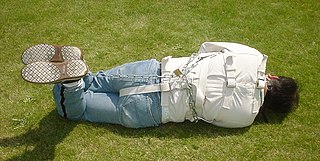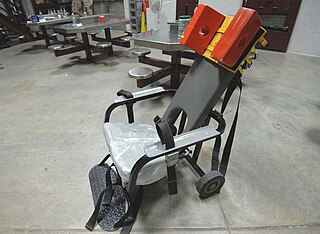Related Research Articles
Involuntary commitment, civil commitment, or involuntary hospitalization/hospitalisation is a legal process through which an individual who is deemed by a qualified person to have symptoms of severe mental disorder is detained in a psychiatric hospital (inpatient) where they can be treated involuntarily. This treatment may involve the administration of psychoactive drugs, including involuntary administration. In many jurisdictions, people diagnosed with mental health disorders can also be forced to undergo treatment while in the community; this is sometimes referred to as outpatient commitment and shares legal processes with commitment.
Outpatient commitment—also called assisted outpatient treatment (AOT) or community treatment orders (CTO)—refers to a civil court procedure wherein a legal process orders an individual diagnosed with a severe mental disorder to adhere to an outpatient treatment plan designed to prevent further deterioration or recurrence that is harmful to themselves or others.

Psychiatric hospitals, also known as mental health hospitals, or behavioral health hospitals are hospitals or wards specializing in the treatment of severe mental disorders, including schizophrenia, bipolar disorder, eating disorders, dissociative identity disorder, major depressive disorder, and others.

Physical restraint refers to means of purposely limiting or obstructing the freedom of a person's bodily movement.

A straitjacket is a garment shaped like a jacket with long sleeves that surpass the tips of the wearer's fingers. Its most typical use is restraining people who may cause harm to themselves or others. Once the wearer slides their arms into the sleeves, the person restraining the wearer crosses the sleeves against the chest and ties the ends of the sleeves to the back of the jacket, ensuring the arms are close to the chest with as little movement as possible.

Solitary confinement is a form of imprisonment in which an incarcerated person lives in a single cell with little or no contact with other people. It is a punitive tool used within the prison system to discipline or separate incarcerated individuals who are considered to be security risks to other incarcerated individuals or prison staff, as well as those who violate facility rules or are deemed disruptive. However, it can also be used as protective custody for incarcerated individuals whose safety is threatened by other prisoners. This is employed to separate them from the general prison population and prevent injury or death.

The hogtie is a method of tying the limbs together, rendering the subject immobile and helpless. Originally, it was applied to pigs and other young four-legged animals.
Medical restraints are physical restraints used during certain medical procedures to restrain patients with (supposedly) the minimum of discomfort and pain and to prevent them from injuring themselves or others.
Emergency psychiatry is the clinical application of psychiatry in emergency settings. Conditions requiring psychiatric interventions may include attempted suicide, substance abuse, depression, psychosis, violence or other rapid changes in behavior.

The Mental Health Act 1983 is an Act of the Parliament of the United Kingdom. It covers the reception, care and treatment of mentally disordered people, the management of their property and other related matters, forming part of the mental health law for the people in England and Wales. In particular, it provides the legislation by which people diagnosed with a mental disorder can be detained in a hospital or police custody and have their disorder assessed or treated against their wishes, informally known as "sectioning". Its use is reviewed and regulated by the Care Quality Commission. The Act was significantly amended by the Mental Health Act 2007. A white paper proposing changes to the act was published in 2021 following an independent review of the act by Simon Wessely.
The Mental Health Act is an Ontario law that regulates the administration of mental health care in the province. The main purpose of the legislation is to regulate the involuntary admission of people into a psychiatric hospital. Since the changes brought about in 2000 under Bill 68, the Act allows for a community treatment order by the attending physician. This order is intended to provide comprehensive treatment outside of a psychiatric facility.
A psychiatric assessment, or psychological screening, is the process of gathering information about a person within a psychiatric service, with the purpose of making a diagnosis. The assessment is usually the first stage of a treatment process, but psychiatric assessments may also be used for various legal purposes. The assessment includes social and biographical information, direct observations, and data from specific psychological tests. It is typically carried out by a psychiatrist, but it can be a multi-disciplinary process involving nurses, psychologists, occupational therapist, social workers, and licensed professional counselors.

Psychiatry is the medical specialty devoted to the diagnosis, prevention, and treatment of deleterious mental conditions. These include various matters related to mood, behaviour, cognition, perceptions, and emotions.
Bridgewater State Hospital, located in southeastern Massachusetts, is a state facility housing the criminally insane and those whose sanity is being evaluated for the criminal justice system. It was established in 1855 as an almshouse. It was then used as a workhouse for inmates with short sentences who worked the surrounding farmland. It was later rebuilt in the 1880s and again in 1974. As of January 6, 2020 there were 217 inmates in general population beds. The facility was the subject of the 1967 documentary Titicut Follies. Bridgewater State Hospital falls under the jurisdiction of the Massachusetts Department of Correction but its day to day operations is managed by Wellpath, a contracted vendor.

Limb restraints can be physical restraints that inhibit an individual's movement in their arms or legs. The most common limb restraint is physical, whereby restraints are fixed to the individual in order to prevent movement of the limbs. They are most commonly used within the field of medicine. However, opposed to physical restraints, chemical restraints are forms of psychoactive medication that intentionally inhibit an individual's behaviour or movement.
Prisoner suicide is suicide by an inmate in a jail or prison.

A restraint chair is a type of physical restraint that is used to force an individual to remain seated in one place to prevent injury and harm to themselves or others. They are commonly used in prisons for violent inmates and hospitals for out of control patients. However, they have also been used to restrain prisoners at Guantanamo Bay detention camp during force-feeding.
Bakırköy Psychiatric Hospital, short for Bakırköy Mazhar Osman Mental Health and Neurological Diseases Education and Research Hospital, is a mental health hospital of the Health Ministry located in Bakırköy district of Istanbul, Turkey. The hospital is named after Mazhar Osman, who is also considered the founder of modern psychiatry in Turkey.
Involuntary commitment or civil commitment is a legal process through which an individual who is deemed by a qualified agent to have symptoms of severe mental disorder is detained in a psychiatric hospital (inpatient) where they can be treated involuntarily.
A high-dependency unit (HDU) is an inpatient psychiatric ward, typically with only a small number of beds, attached to an acute admissions ward. It is intended to provide treatment for patients who cannot be managed safely on an acute (open) ward, but do not meet the threshold for admission to PICU. The number of staff per patient will be higher than the associated acute ward, but may be lower than levels at a PICU.
References
- ↑ Nursing & Midwifery (26 July 2017). "Engagement and Observation in Mental Health Inpatient Units" (PDF). New South Wales Health. Retrieved 22 September 2023.
- ↑ Russ, Mark J (2017). "Constant observation of suicidal patients". Journal of Psychiatric Practice. 22 (5): 382–388. doi:10.1097/PRA.0000000000000175. PMID 27648502.
- ↑ Kiley, Kathleen; Volpe, Diana; Schenkel, Sara Rae; DeGrazia, Michele (2020). "Constant observation of pediatric patients at risk for self-harm and suicide: An evidence-based practice inquiry". Applied Nursing Research. 55 (1). doi:10.1016/j.apnr.2020.151294. PMID 32532475.
- ↑ "'Standing Up to Ezra Pound'". New York Times . September 29, 1991. p. 37. Retrieved 11 August 2019.
- ↑ "Variances Granted by the Board of Correction". NYC Board of Corrections. NYC.gov. November 2005. Archived from the original on 2 December 2011. Retrieved 11 August 2019.
- ↑ Rose, James (16 March 2020). "Counseling in Jail". Counseling Today. Archived from the original on 1 May 2020.
- ↑ "USA: Rights for All: "Not Part of my Sentence" Violations of the Human Rights of Women in Custody". Amnesty International . 1 March 1999. Retrieved 11 August 2019.